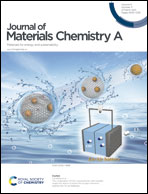Fast lithium-ion conductivity in the ‘empty-perovskite’ n = 2 Ruddlesden–Popper-type oxysulphide Y2Ti2S2O5†
Abstract
Materials with Wadsley–Roth (W–R) crystallographic shear and bronze-type structures display fast lithium (Li)-ion diffusion and are of interest as anode materials for high-power Li-ion batteries. Here we use density-functional-theory calculations to investigate Y2Ti2S2O5, a Li-ion anode material that shares structural features with W–R phases. Y2Ti2S2O5 is a layered Ruddlesden–Popper-type oxysulphide displaying a reversible capacity of 128 mA h g−1, with 60% capacity-retention at a charge rate of 20C in micrometer-sized electrode particles. The crystal structure contains an empty central layer of corner-sharing [TiO5S] octahedra, equivalent to a (∞ × ∞ × 2) block of the ReO3-like units that form Wadsley–Roth type phases. Intercalated Li+ ions on this plane occupy distorted ‘rectangular-planar’ sites, and display 2D mobility with single-ion hopping barriers of 64 meV under dilute conditions. The insertion geometry of Li+ is highly frustrated, giving rise to a smooth potential energy surface for Li-hopping and exceptionally low activation barriers. The [TiO5S] units do not experience major distortions or correlated rotations during discharge, due to framework rigidity provided by [Y2S2]2+ rocksalt slabs, meaning the rectangular-planar-like geometry of Li+ is retained across all states of charge. A tetragonal to orthorhombic to tetragonal phase change occurs upon lithiation, with a stable Li+ ordering at x = 1.0 in LixY2Ti2S2O5. Li+–Li+ repulsion has a significant effect on the cation ordering at all Li intercalation levels. Na+ hopping barriers are >1.7 eV, while Mg2+ ions can move with barriers of ∼607 meV, illustrating the how diffusion behaviour varies for ions of different size and charge within W–R-type frameworks. The exceptionally low activation barriers for Li-hopping and well-defined, rigid 2D diffusion plane makes Y2Ti2S2O5 a valuable model system within which to understand Li+ behaviour in high-rate electrode materials, such as the related Wadsley–Roth phases.



 Please wait while we load your content...
Please wait while we load your content...